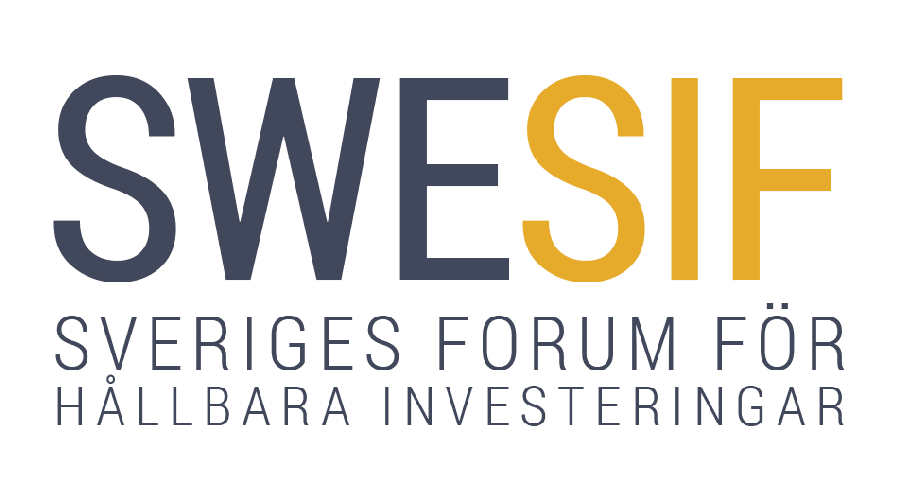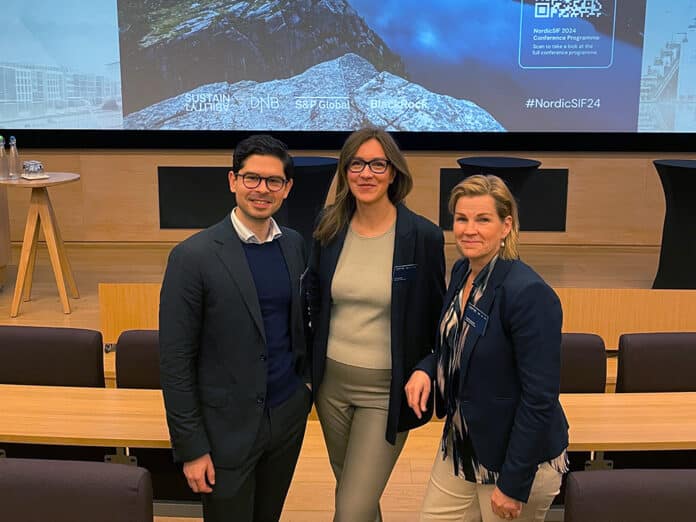Den 12 juni gick den årliga NordicSIF-konferensen av stapeln. På plats var Edson Fonseca, Victoria Lidén och Anette Carmelius från Swesifs styrelse. För dig som inte hade möjlighet att delta, har Finsif skrivit ett blogginlägg som sammanfattar dagarna i Oslo. Vänligen se nedan.
A full day of discussion, panels, presentations and networking among sustainable investment professionals from across the Nordics. Each Nordic country has a Sustainable Investment Forum (SIF) that operates independently and comes together once a year at the NordicSIF conference. This year’s cross pollination of FINSIF, NORSIF, SWESIF, DANSIF and ICELANDSIF took place in Oslo, with the net-zero transition as the topic for discussion.
Before the conference, representatives from the boards of all five SIFs met and discussed how to deepen cooperation between countries and the concepts for the upcoming NordicSIFs, 2025 in Stockholm and 2026 in Helsinki. Leila Räsänen and I represented FINSIF in these discussions, which left me with a sense of invigoration and optimism about the future of Nordic SIF cooperation. We encourage members who have participated in previous NordicSIF events to reach out with ideas and requests of how to make the future conferences the best they can be.
Wednesday, the conference kicked off in DNB’s Oslo headquarters, with a packed schedule of interesting speakers and panels. For those who could not attend, I have summarized my takeaways from each of the presentations below.
Session 1: Scientific scrutiny of Sustainability
Alex Edmans London Business School
- Confirmation bias is prevalent throughout Sustainability communications.
- Investors need to critically scrutinize Sustainability claims to get to the real evidence.
- This provides opportunity, because truly sustainable, transformative companies are not easy to find – and hence there are likely to provide alpha.
My take: what data points can we use to compare the Sustainability performance of companies across industries?
Session 2: The role of the Nordic financial services industry in the transition
Kjerstin Braathen , DNB
- Renewable energy investment is increasing, despite recent underperformance, signaling a long-term commitment to the transition.
- There is a large opportunity for Sustainability products, however we need expert input to ensure that the linked criteria are appropriate (eg nature vs only climate).
- Banks and financiers might well be the Sustainability touchpoints for SMEs that can’t afford to employ external experts.
My take: I see this last point as a key trend and the reason that banks and the broader financial community needs to build fit-for-purpose Sustainability capacity (including nature!).
Session 3: Norway’s climate transition
Martin Skanke, Climate Committee 2050
- Effective planning of our future economy needs to work backwards from 2050, rather than forwards from today.
- >90% emission reductions means we must connect to broader sector connections (land use, food systems, energy). Climate policy cannot be realistically silo’d from other issues.
- Financial professionals need to judge: does my investment have a place in the economy of 2050?
My take: Norway has so far paid other countries to reduce emissions on their behalf, rather than drive domestic emission reduction. This only postpones the transition needed, if the country is to truly achieve its 2050 target of >90% reduction.
Session 4: The transition in the energy market
Jarand Rystad Rystad Energy
- The energy transition means more from less because of increases in efficiency!
- 24 key technologies that will Disrupt the energy market – providing energy service that is cheaper and better.
- Solar PV, batteries and electrification are the future champions.
My take: We mustn’t aim to solve climate through simultaneous nature destruction. Potential solutions to land-use challenges aim to combine ’land-hungry’ solar with other technologies.
○ Agrivoltaic solar farms
○ Water-based solar farms
Session 5: Energy transition Outlook – the Norwegian perspective
Sverre Alvik DNV
- Norway is the 2nd most electrified country, after Iceland.
- However, the energy transition means significant shocks to the Norwegian economy – based heavily on fossil fuel exports.
- Norwegian hydro could act as a pumped battery for the European energy system.
- Hydrogen is never the first choice, only useful if electrification doesn’t work for a particular industry or use-case (eg maritime transport). The demand for hydrogen exports is a significant opportunity for Norway, but other countries are also waking up to this.
- Oil will structurally decline, while production of Norwegian gas will remain through 2050 (likely supporting blue hydrogen production).
My take: It is important to dig Deeper into Oil & gas as a sector, there might be declines in oil with simultaneous growth in gas to support new technologies like blue hydrogen.
Session 6: Panel: The energy transition
- How will equity valuation change when we start to price in the externalities? The question is different when damage to nature is not free. (Hans Thrace Nielsen, Storebrand).
- Taxes work. However, current taxes are not large enough to rock the boat of fossil fuel production (Hans Thrace Nielsen, Storebrand).
- Even in a 1.5C scenario, Europe will be short oil and gas supply, why to stop ’relatively clean’ production from Norway and source this from elsewhere? (Torbjorn Kjus , Aker ASA).
- There is still year-on-year growth in the oil and gas market. Public opinion of how quickly Equinor will transition to renewable EBIT is probably overly ambitious. (Teodor Sveen-Nilsen, SpareBank 1 Markets AS).
My take: This was a discussion I was interested in, the elephant in the room, tackling climate change in a Norwegian economy heavily dependent on fossil energy. Unfortunately, no easy answers.
Session 7: Panel: opportunities in the new green industries
Stina Torjenen , Morrow Batteries
-
- Batteries are not one-size-fits-all, R&D is key in this sector as new chemistries are developed.
- China is 10 years ahead in batteries and has already scaled. Tailor made solutions for EU customers is an opportunity for local producers.
- The EU will support local battery supporters through regulations that are difficult to comply with for Asian competitors.
Marielle Furnes Mannseth, Norweigan Hydrogen:
- Hydrogen will be key in a net-zero future to power heavy duty processes & maritime transport.
- ’Hydrogen’ represents a range of products, the value chain for these is nascent but developing. Cooperation is needed from customer product designers (eg ship builders).
- Oil and gas expertise can transfer to green hydrogen, this is a strategic opportunity for Norway.
My take: there will be serious competition in the future to dominate the production of hydrogen, countries that are serious about this need to move fast and hard.
Session 8 Panel: Investor Collaboration in the real world
Jan Erik Saugestad , Storebrand Asset Management
- Divestment is not very effective to drive transformation in companies.
- Nature: there needs to be a focus on land use and deforestation, alongside climate.
- Bringing together investors from many countries has proven impactful (eg when engaging with Brazilian companies).
- A level playing field is key, we need to ensure strategic sustainable investments are profitable.
- Investors mustn’t be afraid of engaging with government!
My take: Local investors need to form alliances to strengthen their voice. Real leverage exists within regional companies where investors often have the best networks and highest expertise. This is the low-hanging fruit for Deeper engagement on climate and nature issues.
Annie Bersagel, Folketrygdfondet:
- Local Investor Collaboration on engagement is much more effective, this is low-hanging fruit – Collaborate with your neighbours!
- It’s critical to define the objective of what investors are trying to get out of dialogues.
Session 9: Fireside chat: The transition’s effect on short, and long-term allocation
Kjersti Haugland DNB Markets
- EU tends to use sticks:- regulations, taxes to shift harmful activities towards the green transition, this can increase prices and spur inflation.
- US tends to use carrots:- the Inflation Reduction Act, as a large subsidy partly targeting the green transition, will ironically also spur inflation.
- 3% inflation could become the new normal within the green transition and new geopolitical scenario.
My take: we need macro incentives to push and pull our economies towards the green transition. These will be painful and expensive – it remains to be seen how politically palatable this can be. Recent EU elections highlight this.
Session 10: The geopolitical dimension
Ulf Sverdrup Norwegian Business School
- Politician’s problem of the green transition: We all know what to do, but we don’t know how to get re-elected once we have done it.
- Global economic power is shifting to autocracies, this is a dramatic departure from the rule of thumb of the last 100 years.
- The EU will have to dramatically increase security spending – this will impact the ability to fund the green transition.
- If he wins, Trump v2 will be much more radical than Trump v1.
- Interesting history lesson: Regean to Gorbachev in a Cold War meeting, ’If Aliens attacked us, would you defend us?’ Gorbachev: ’Yes.’ This is the attitude we need now to tackle the Planetary crisis amid geopolitical conflicts.
My take: Our world is moving from relative stability into a period of instability. Our own ability to deal with this and maintain communication with across the new lines drawn around the world will define our future.
That was my summary and take on the stacked line up of speakers at NordicSIF 2024, thanks again to NorSIF who were wonderful hosts. I encourage FINSIF members to get involved and attend the next NordicSIF conference in Stockholm next year!
 The article is authored by Jarrod Luxton, member of the Board and part of Finsif’s NordicSIF working group, and Senior Lead at Sitra.
The article is authored by Jarrod Luxton, member of the Board and part of Finsif’s NordicSIF working group, and Senior Lead at Sitra.


